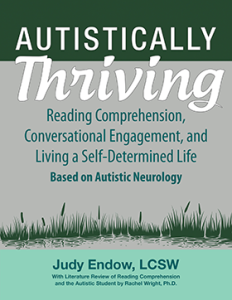It happened again. An autistic was murdered by his mother. His name was Alejandro and he was 9 years old. The news media shares story as if the story is about Alejanro’s mother and not about him. For some reason, in our warped culture, being autistic means you don’t count – you are not considered human being enough to count even after someone tries to murder you! In fact, you will likely not even be part of the story after the first few sentences. The story quickly becomes one of excuses for the mother or caregiver who murders the autistic.
At our core, as a society, we hold the belief that a disabled person is better off dead. We don’t actually talk about this belief, but it is what is underneath when so many can read the story and agree with and sympathize with the murderer. In no other murder scenario do we do this – sympathize with the murder and blame lack of services. Disabled people are construed as a burden to their families and are even thought to be the fault of their own murders! Sympathy starts pouring in for the poor murderer who had no choice and who, in fact, did what any one else would be driven to do under the same circumstances is what we are told by news stories and social media commenters.
WRONG
WRONG
WRONG
There are ever so many things wrong with this story line we see repeated about the “unfortunate tragedy” due to the “lack of services” for the family of an autistic person, while writing out the actual autistic person who was in fact murdered or had an attempt of murder carried out against her.
Here are some facts the news reports do not tell us:
1. Autistic people are human beings. Human beings do not deserve to be murdered. PERIOD. NO ifs, ands or buts.
2. Autistic people’s lives are not worth less than other people’s lives.
3. Autistic people do NOT cause their caregivers to murder them.
4. Lack of services is not a reason for murder.
5. If you are a parent or caregiver and feel the only way out is to murder your child you are in crisis. Call a crisis line. Your child may be removed from your care temporarily. Foster care isn’t great, but it will keep your child alive while your crisis state can be addressed.
I know by writing this I will have many parents of autistic children jump all over me saying all the usual things they say. So, I will tell you a bit about me ahead of time.
I was “severe” enough as a child to be institutionalized. As a teen I lived in two foster care arrangements that were not appropriate for an autistic teen. One was a group home for mentally retarded adults (that word was not a bad word at the time) even though I was neither mentally retarded or an adult. The other was a group home for delinquent teens; I was a teen, but not delinquent.
It took me a long time to grow up, but I did grow up. As a parent I was told my autistic son had failed all the services my county and state had to offer and that I should call the police when he became violent.
I foster parented a severely autistic teen for a short time. I went to college. I got a master’s degree in social work. I worked in clinical settings. Eventually, I limited my practice to autism. Today I have my own business. I am an author, consultant, artist and international speaker on autism topics.
I write all this about myself because, nearing retirement, I have experienced all sides of this many-faceted story. I know how it feels to be the victim, the mother, the caregiver and the social worker. I understand foster care from the angle of the kid in the system, the foster parent and the social worker. And I can tell you that at the end of the day no matter how I look it I know this:
IT IS WRONG TO MURDER YOUR AUTISTIC CHILD.
If murder is looking like a solution to you it means you are near the breaking point and need help. Call your local crisis center and say these words, “I am thinking about murdering my autistic child and here is how I would do it.” Then tell them your plan. If you do not have a local crisis hot line go to the nearest hospital emergency room and say the same words. It is not a perfect solution. It is a crisis solution, but will ensure you get someone to help you in the moment because murder is not a solution to your problem.
Here is the link to the original news story from the weekend.
BOOKS BY JUDY ENDOW
Endow, J. (2019). Autistically Thriving: Reading Comprehension, Conversational Engagement, and Living a Self-Determined Life Based on Autistic Neurology. Lancaster, PA: Judy Endow.
Endow, J. (2012). Learning the Hidden Curriculum: The Odyssey of One Autistic Adult. Shawnee Mission, KS: AAPC Publishing.
Endow, J. (2006). Making Lemonade: Hints for Autism’s Helpers. Cambridge, WI: CBR Press.
Endow, J. (2013). Painted Words: Aspects of Autism Translated. Cambridge, WI: CBR Press.
Endow, J. (2009). Paper Words: Discovering and Living With My Autism. Shawnee Mission, KS: AAPC Publishing.
Endow, J. (2009). Outsmarting Explosive Behavior: A Visual System of Support and Intervention for Individuals With Autism Spectrum Disorders. Shawnee Mission, KS: AAPC Publishing.
Endow, J. (2010). Practical Solutions for Stabilizing Students With Classic Autism to Be Ready to Learn: Getting to Go.Shawnee Mission, KS: AAPC Publishing.
Myles, B. S., Endow, J., & Mayfield, M. (2013). The Hidden Curriculum of Getting and Keeping a Job: Navigating the Social Landscape of Employment. Shawnee Mission, KS: AAPC Publishing.












